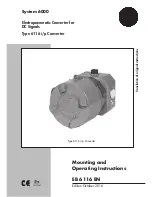
FM Subsystem
FM Subsystem
This summarizes the steps required to generate a frequency modulation (FM) waveform.
1.
Configure carrier waveform:
Use
,
, and
to specify the carrier
waveform's function, frequency, amplitude, and offset.
2.
Select modulation source (internal, external, CH1, or CH2):
. For an external modulation
source, skip steps 3 and 4.
3.
Select modulating waveform:
4.
Set modulating frequency:
5.
Set peak frequency deviation:
6.
Enable FM Modulation:
[SOURce[1|2]:]FM[:DEViation] {<
peak_deviation_in_Hz
>|MINimum|MAXimum}
[SOURce[1|2]:]FM[:DEViation]? [{MINimum|MAXimum}]
Sets the peak frequency deviation in Hz. This value represents the peak variation in frequency of the
modulated
wave-
form from the carrier frequency.
Parameter
Typical Return
1 μHz to 15.05 (limited to 150 kHz for RAMP); default 100 Hz
+1.00000000003
Set peak frequency deviation to 1 kHz:
FM:DEV 1000
Set peak frequency deviation to 1 μHz:
FM:DEV MIN
l
The deviation cannot exceed the carrier frequency. If you attempt to set a deviation that exceeds the carrier
frequency (with FM enabled), the instrument will adjust the deviation to the maximum value allowed for that car-
rier frequency.
From the remote interface, a "Settings conflict" error will also be generated.
l
The carrier frequency plus the deviation cannot exceed the selected function's maximum frequency plus 100 kHz.
If you attempt to set the deviation to an invalid value, the instrument adjusts it to the maximum value allowed
with the present carrier frequency. The remote interface also generates a "Data out of range" error.
l
If the deviation causes the carrier waveform to exceed a frequency boundary for the current duty cycle (square
waveform only), the instrument will adjust the duty cycle to the maximum value allowed with the present carrier
frequency.
From the remote interface, a "Settings conflict" error will also be generated.
l
If you select the
External
modulating source, the deviation is controlled by the ±5 V signal level on the rear-panel
Modulation In
connector.For example, if the frequency deviation is 100 kHz, then a +5 V signal level cor-
responds to a 100 kHz increase in frequency.Lower external signal levels produce less deviation and negative sig-
nal levels reduce the frequency below the carrier frequency.
[SOURce[1|2]:]FM:INTernal:FREQuency {<
frequency
>|MINimum|MAXimum}
[SOURce[1|2]:]FM:INTernal:FREQuency? [{MINimum|MAXimum}]
Sets the frequency of the modulating waveform. The modulating source waveform operates at that frequency, within
the frequency limits of that waveform.
196
Agilent 33500 Series Operating and Service Guide














































